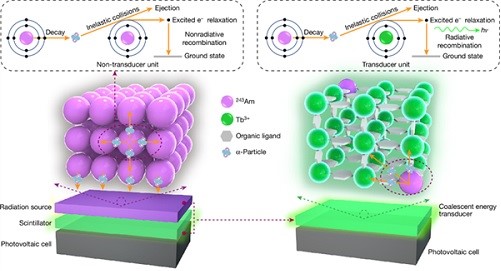In the cutting-edge exploration of energy technology, a major scientific research breakthrough originating from China is leading the world's attention. The scientific research team led by Professor Wang Zhenwa and Professor Wang Yaxing of Soochow University, together with top academic institutions in China, proposed a revolutionary "built-in energy converter" actinide miniature nuclear battery design concept, which successfully increased the efficiency of radionuclide decay energy into light energy to an unprecedented level of nearly 8,000 times, and successfully assembled the prototype of radiated photovoltaic nuclear cell with the most outstanding efficiency known at present, opening up a new era for global energy technology and nuclear waste resource utilization.
Technological innovation: a milestone in reshaping the value of nuclear waste
The core value of this technology lies not only in its technological innovation and breakthrough, but also in the fact that it provides a new resource utilization path for actinides, a long-term radioactive pollution source in nuclear waste. Actinides, as the main contributors to radiotoxicity in nuclear waste, were once regarded as difficult problems due to their ultra-long half-life and high-energy α decay characteristics. Now, through the precision molecular design and optimization of the Soochow University team, these "double-edged sword" elements have been cleverly combined with luminescent lanthanide elements to achieve a leap in energy conversion efficiency, showing a magnificent transformation from waste to resources.
Excellent performance: the double guarantee of stability and efficiency
The experimental data fully verified the extraordinary performance of the miniature nuclear battery. At very low doses (only 11 μCi) of radionuclides, the cell exhibits remarkable self-luminescence, with a luminous power of up to 11.88 nW and an impressive conversion efficiency of 3.43% from decay energy to light energy. In particular, the performance of the battery remained stable for 200 hours of continuous testing, with no significant attenuation, demonstrating its excellent structural stability and luminous durability. This performance has laid a solid foundation for the long-term application of miniature nuclear batteries in extreme environments.

Pictured: Chinese scientists convert nuclear waste into miniature nuclear batteries that can be used for thousands of years
Application prospects: a new era of energy self-sufficiency
The successful research and development of this technology indicates that the micro nuclear battery will show its unique application value in many fields. In extreme environments such as deep-sea exploration and space exploration, miniature nuclear batteries are expected to become an indispensable energy solution due to their ultra-long life and stable performance. Theoretically, its service life can be as long as thousands of years, providing near-infinite energy support for long-term, continuous operation of equipment, which is of immeasurable significance for promoting the development of cutting-edge fields such as deep-sea scientific research and interstellar travel.
Global Impact: Promoting Energy Transition and Sustainable Development
In the long run, the popularization and application of this technology is expected to trigger profound changes in the energy sector on a global scale. The high efficiency and durability of micro nuclear batteries will greatly reduce dependence on fossil fuels and help transform the global energy structure to a cleaner and low-carbon direction. At the same time, the conversion of nuclear waste into usable energy not only effectively alleviates the problem of nuclear waste disposal, but also provides new ideas for the development of sustainable energy technology, and contributes to global environmental protection and green development.
Conclusion: The light of science and technology illuminates the road of future energy
This milestone research result of the Soochow University team is not only a major breakthrough in the field of nuclear radiochemistry in China, but also a brilliant achievement in the field of global energy science and technology. It not only shows the infinite possibilities of scientific and technological innovation, but also shows us that through wisdom and efforts, human beings are fully capable of transforming waste into valuable resources, and then promote the profound transformation and sustainable development of the global energy structure. With the further maturity and application of this technology, we have reason to believe that the future energy world will be more diversified, clean and sustainable, providing a solid and reliable energy guarantee for the sustainable development of human society.






